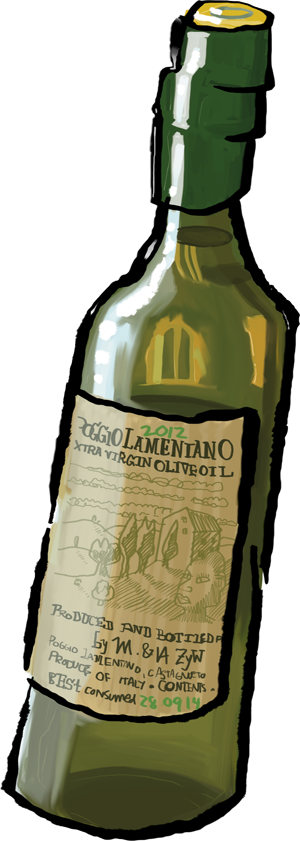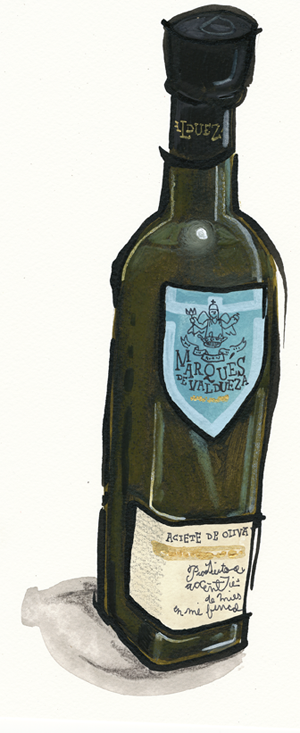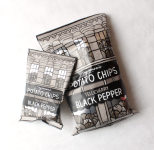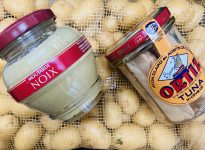Five Fantastic Olive Oils
 Poggio Lamentano Olive Oil from Tuscany
Poggio Lamentano Olive Oil from Tuscany
Fritz Maytag, founder of Anchor Steam brewery, once said, “There are a lot of good products out there, and there ‘s a lot of good stories. The challenge is to find a great product that’s also got a great story behind it.” I agree. Fortunately, we have more than our fair share of those here at Zingerman’s. I can happily report that we have one more to offer. Poggio Lamentano is a terrific Tuscan olive oil crafted by artist and farmer Michael Zyw. You can check out much of his amazingly colorful and wonderful work online. But, if you stop by the Deli you can see a bit of his work on the label of the oil. It’s a pencil sketch, a study in grays and whites, an arresting and complex image, which fits because the oil is equally complex. It has much of the bold pepperiness and flavor of fresh-cut grass and artichoke that are hallmarks of Tuscan oil, but as is often the case the location near the sea seems to bring a nice softness to the mix.
The oil is unfiltered, which I believe helps enhance the complexity of the flavor. It starts soft with a bit of banana and green grass, the pepper pops up in the back and it finishes in a forcefully refined way. I’ve been eating the Poggio Lamentano on the Martelli family’s spaghetti, on fresh mozzarella, on simple salads of arugula with a bit of grated Tuscan pecorino cheese, a few chopped hazelnuts and a bit of roasted red pepper. Definitely great with beans. I’ve used it to finish off a few fish stews to great effect. Excellent for dipping steamed artichoke leaves. Maybe it’s best at its most basic—poured liberally onto toasted Farm or Paesano breads from the Zingerman’s Bakehouse.
 Marqués de Valdueza from Merida
Marqués de Valdueza from Merida
As a history major I have to admit to being moderately biased toward this oil—you’d be hard-pressed to find any product that’s a whole lot more rooted in family and national history than this. The family, formally known as the House of Alvarez de Toledo, has been a fixture in Spanish history for something like ten centuries. I can’t tell you it’s some romantic rags to riches story—at least for the last nine hundred years, the family has been hugely successful. Best I can tell, quality and care have been a part of most everything they have done, and this oil is no exception.
The Valdueza oil is very well made and it shows. No defects, long finish, good complexity. It’s made from a unique blend of four different varietals that grow on the farm. By going in person last year I got to taste each of the varietals on its own, as well as the finished Valdueza coupage. Hojiblanca and Picual are standard varietals from southern Spain and are not uncommon out west as well. The former brings a soft, warm, nutty butteriness; the latter offers hints of artichoke, green asparagus, a bit of earthiness, and a touch of black pepper in the finish. Arbequina arrived in the region only recently, planted for its good yields and round soft flavor; here in Extremadura, at least on the Toledo de Alvarez family farm, it tastes a bit different than what I’ve experienced in Catalonia where it typically comes from—less appley, more olivey. Most interesting to me is the oil from the Morisca olives, which are unique to the area They offer a fair bit of pepper, and interesting fruit, almost apricot in a way, with a touch of green grass and green tomato in there, too.
For those of you who follow these things (and there are many!) I’d put the flavor profile of the finished oil in about the middle of the range—less green than the Tuscans, less earthy than most southern Spanish Picuals. All told they produce about 30,000 bottles a year—huge by the standards of artisan friend Mariano Sanz, but relatively modest by comparison to any large-scale commercial producer. This past autumn, the weather was very dry—not great for yields, but generally, in my experience, very good for the flavor of the oil. As is true of all these high-end, well made oils, there’s a complexity and an elegance (and a commensurate higher cost) that will likely mean that you’ll want to use it for finishing—at the table to drizzle on great greens from the market, on top of a bit of roasted meat or vegetables.
If you’re thinking of this one as a gift, you’ll appreciate its beautiful light blue label. I like it, in part, just because I love the color, but also because I’ve never seen it on any other olive oil.
Desert Miracle Olive Oil from Morocco
An excellent, relatively new arrival from the Southern Mediterranean, the Desert Miracle is buttery, sweet and very delicious. An ideal match for vegetables or fish, the Desert Miracle oil is from olives grown at the Aqallal family’s El Bourouj farm. The fields are all at an altitude of a 1000 feet (higher altitudes like this generally have lower yields but more interesting flavors). The farm is actually located right in the desert, hence the name. It’s a bit of a miracle that trees are growing in this region at all. There are over 300,000 trees on the land. The added stress from growing in desert conditions (the trees get very little irrigation) also adds to the complexity of the flavor. The olives are Arbequina (of Spanish origin) and Dahbia (an old varietal that’s unique to Morocco). Part of what makes the oil so special is a system that the Aqallals have developed that allows the olives to be picked with gentle machinery and then pressed within 20 minutes of being picked. I had to check that stat about six times, but sure enough, the number is accurate—twenty minutes from tree to crush. The trees at the El Bourouj farm are on the younger (about 2—25 years old) side of things and can stand up well to the machine picking. The oil really is delicious. Delicate, mellow, sweet, a tiny taste of apple (typical of Arbequina olives), with a tiny bit of spicy pepperiness at the end. It’s great on new potatoes, with simple salads of the delicate lettuces from the farmer’s market, or on a piece of fresh fish.
Terroir de Marrakech
A second superb oil from the same family, this one comes from a different farm that’s north of Marrakech. In the years before independence, the land belonged to the Rothschild family. The oil is really the Aqallal family’s point of pride—it’s made only from very old (all over one hundred years) trees, all growing at over 1200 feet. The age and great size of the trees dictates that picking must be done still by hand, and the olives are in the press in less than 24 hours (normally an impressive stat, except in this case when you compare to the miraculous twenty minute time span they’ve got working for the Desert Miracle).
The olives for this oil are primarily the French Picholine du Languedoc with some Menarz and Haouzia. The flavor of the Terroir de Marrakech is pretty marvelous and quite unique—the hallmark, perhaps, of what Moroccan olive oil is all about. Still softer in flavor than Poggio Lamentano, but with bigger fruit and more intensity than milder Desert Miracle. Nicely round, a bit sweet, elegant with hints of tarragon and green asparagus. Serve it on salads, couscous. Really good with roasted vegetables. This is a very special oil that shows the world just how good Moroccan oil can be.
Planeta Olive Oil from Sicily
The boldest oil on our shelves this season, Planeta is big, green, very grassy, and wonderfully peppery. It’s not for everyone but it is for me. Although it’s so green and so bold that it seems like it could well come from another planet, the oil is actually named for the Planeta family who produce it. They farm in the southwest Sicily, near the town of Menfi, and are probably better known internationally for their award-winning wines. The family has been farming the area for many generations. The olives are primarily a blend of the three main varieties of Sicily— Cerasuola, Biancolilla and Nocellara de Belice. The Nocellara are the biggest portion of the blend, and also the biggest in flavor. There’s a small bit of three other varietals in the mix—Giarraffa (by name at least, my favorite olive varietal), Santagatese and Ogliarola Messinese. All the olives are handpicked, usually a couple of weeks before others in the area. The extremely early harvest is a big factor in the boldness of the flavor, but again, keeps yields small. The oil is a certified DOP (a protected denomination of origin), which means that it must pass rigorous testing before it can be bottled and sold. The color is bright green and so is the flavor with notable hints of fresh cut grass, green tomato, green peppercorn, maybe a hint of citrus. I love it on toast, on beans, on beef, or on a simple bowl of pasta topped with nothing more than salt, pepper, Planeta oil and a bit of Parmigiano Reggiano cheese. If you like your oil very big and very bold like I do, don’t miss this one—you won’t forget it easily!




Zingerman’s Art for Sale